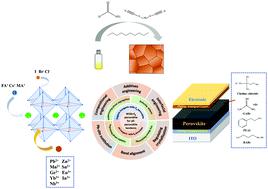当前位置:
X-MOL 学术
›
Energy Environ. Sci.
›
论文详情
Our official English website, www.x-mol.net, welcomes your feedback! (Note: you will need to create a separate account there.)
Wide-bandgap organic–inorganic hybrid and all-inorganic perovskite solar cells and their application in all-perovskite tandem solar cells
Energy & Environmental Science ( IF 32.5 ) Pub Date : 2021-09-21 , DOI: 10.1039/d1ee01562a Rui He 1 , Shengqiang Ren 1 , Cong Chen 2 , Zongjin Yi 1 , Yi Luo 1 , Huagui Lai 3 , Wenwu Wang 1 , Guanggen Zeng 1 , Xia Hao 1 , Ye Wang 4 , Jingquan Zhang 1 , Changlei Wang 5 , Lili Wu 1 , Fan Fu 3 , Dewei Zhao 1
Energy & Environmental Science ( IF 32.5 ) Pub Date : 2021-09-21 , DOI: 10.1039/d1ee01562a Rui He 1 , Shengqiang Ren 1 , Cong Chen 2 , Zongjin Yi 1 , Yi Luo 1 , Huagui Lai 3 , Wenwu Wang 1 , Guanggen Zeng 1 , Xia Hao 1 , Ye Wang 4 , Jingquan Zhang 1 , Changlei Wang 5 , Lili Wu 1 , Fan Fu 3 , Dewei Zhao 1
Affiliation

|
The past decade has witnessed rapid development of perovskite solar cells (PSCs), the record power conversion efficiency (PCE) of which has been rapidly boosted from the initial 3.8% to a certified 25.5%, approaching the Shockley–Queisser (SQ) limit for single-junction solar cells. Tandem solar cells (TSCs) have gradually attracted more attention due to their great potential to break the SQ limit by reducing the thermalization losses. Among various kinds of perovskite-based tandems, all-perovskite TSCs offer great promise with the advantages of solution processability, low cost, and flexibility. As top cells for TSCs, the wide-bandgap (wide-Eg, >1.7 eV) PSCs play an essential role in harvesting the high-energy photons and providing high open-circuit voltage (Voc) for the multi-junction TSCs, which is helpful for maintaining the stability of the bottom cell by filtering harmful ultraviolet radiation. However, both organic–inorganic hybrid perovskites and all-inorganic perovskites encounter several problems, such as the phase instability and the large Voc deficits (Eg/q − Voc), which result in inferior performance of wide-Eg PSCs. Many efforts have been made to overcome the issues and researchers have already made encouraging progress. In this review, we summarize the recent progress on wide-Eg PSCs based on organic–inorganic hybrid perovskites and all-inorganic perovskites, as well as their application in all-perovskite TSCs. Finally, the main challenges and perspectives are discussed.
中文翻译:

宽带隙有机-无机杂化和全无机钙钛矿太阳能电池及其在全钙钛矿串联太阳能电池中的应用
过去十年见证了钙钛矿太阳能电池 (PSC) 的快速发展,其创纪录的功率转换效率 (PCE) 从最初的 3.8% 迅速提升到认证的 25.5%,接近肖克利-奎塞尔 (SQ) 极限单结太阳能电池。串联太阳能电池(TSC)由于其通过减少热化损失来突破 SQ 限制的巨大潜力而逐渐引起了更多关注。在各种基于钙钛矿的串联材料中,全钙钛矿 TSCs 具有溶液可加工性、低成本和灵活性的优势。作为 TSC 的顶级电池,宽带隙(宽E g,>1.7 eV)PSC 在收集高能光子和提供高开路电压(V oc) 用于多结 TSC,通过过滤有害的紫外线辐射有助于保持底部电池的稳定性。然而,有机-无机杂化钙钛矿和全无机钙钛矿都遇到了一些问题,例如相不稳定性和大的V oc缺陷(E g / q - V oc),这导致宽E g PSC 的性能较差。为克服这些问题做出了许多努力,研究人员已经取得了令人鼓舞的进展。在这篇综述中,我们总结了宽E g的最新进展基于有机-无机杂化钙钛矿和全无机钙钛矿的 PSC,以及它们在全钙钛矿 TSC 中的应用。最后,讨论了主要挑战和前景。
更新日期:2021-10-06
中文翻译:

宽带隙有机-无机杂化和全无机钙钛矿太阳能电池及其在全钙钛矿串联太阳能电池中的应用
过去十年见证了钙钛矿太阳能电池 (PSC) 的快速发展,其创纪录的功率转换效率 (PCE) 从最初的 3.8% 迅速提升到认证的 25.5%,接近肖克利-奎塞尔 (SQ) 极限单结太阳能电池。串联太阳能电池(TSC)由于其通过减少热化损失来突破 SQ 限制的巨大潜力而逐渐引起了更多关注。在各种基于钙钛矿的串联材料中,全钙钛矿 TSCs 具有溶液可加工性、低成本和灵活性的优势。作为 TSC 的顶级电池,宽带隙(宽E g,>1.7 eV)PSC 在收集高能光子和提供高开路电压(V oc) 用于多结 TSC,通过过滤有害的紫外线辐射有助于保持底部电池的稳定性。然而,有机-无机杂化钙钛矿和全无机钙钛矿都遇到了一些问题,例如相不稳定性和大的V oc缺陷(E g / q - V oc),这导致宽E g PSC 的性能较差。为克服这些问题做出了许多努力,研究人员已经取得了令人鼓舞的进展。在这篇综述中,我们总结了宽E g的最新进展基于有机-无机杂化钙钛矿和全无机钙钛矿的 PSC,以及它们在全钙钛矿 TSC 中的应用。最后,讨论了主要挑战和前景。



























 京公网安备 11010802027423号
京公网安备 11010802027423号